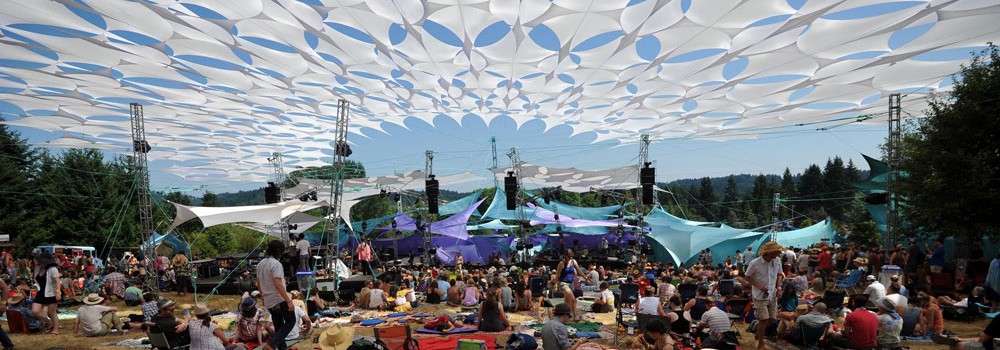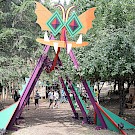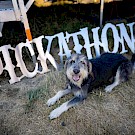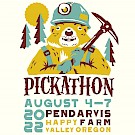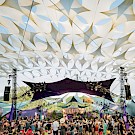If you’ve never been to Pickathon, what you’re about to read may sound like a public service announcement. Once you go, you’ll wonder what kept you away for so long. It’s addictive. This gleaming jewel of Happy Valley—just east of Portland—has many elements that make up the Pickathon experience, and here’s the story of but a few.

SUSTAINABILITY
It’s the one word that’s most associated with Pickathon. Literally, the term refers to the ability to continue a defined behavior indefinitely. In addition to the environmental definition, it is this general context that founder Zale Schoenborn refers to when he talks about the festival he created. To Schoenborn and his team, Pickathon must be a festival that they themselves would want to attend. The work they do has to be challenging enough, rewarding enough and inspiring enough to make it worth doing every year.
The organic seeds of Pickathon’s environmental vision have their roots in the principal’s principles. When Schoenborn first approached Pendarvis Farm owners Sherry and Scott Pendarvis in 2006 with the idea of moving the festival to their 80-acre plot, the Pendarvises experienced flashbacks to a recent farm event where leftover litter, mounds of cans and bottles, and spent batteries discarded in the fire pit put them on high, red-flag alert: They agreed to it, only if the festival could do it cleanly and sustainably.
Pickathon seems to have broken all the traditional rules of how to throw a music festival: Their no-single-use-plastic-anything policy is one such example. In 2011, Pickathon phased out single-use utensils and dishware. And just the year prior, history was made when Pickathon became the first multi-day music festival in the country to replace plastic cups with reusable metal ones that patrons could purchase and take home as souvenirs.
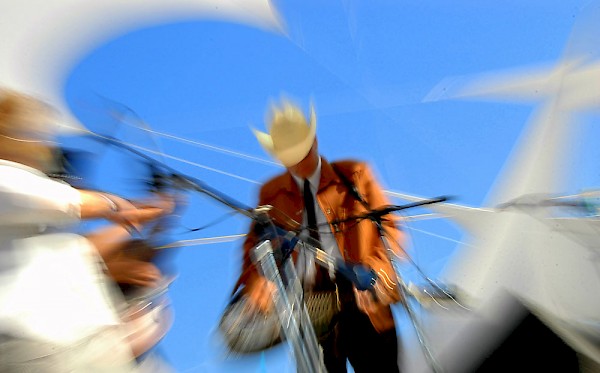 The Wilders
The Wilders
As conscientious stewards of the land, it makes sense that the festival is solar-powered. Pendarvis Farm removes invasive plant species from its fields and forests while creating wildlife corridors so that the critters have somewhere to go once hundreds of campers take up temporary residence in the forest. The list goes on. One of the most impressive effects of this eco-friendly philosophy is seen in the festival’s public who agree to leave only footprints when they camp and frolic on the pristine land.
Pickathon’s environmental sensibilities run deep. Schoenborn’s politically active parents, Ted and Carol Schoenborn (who some refer to as Pickathon’s “secret weapon”) were present for the first-ever Earth Day. After moving from Washington D.C. to Kentucky, the family regularly attended bluegrass music events. Schoenborn and his brother, Eric, roamed free and unsupervised. These experiences shaped the family, who have been all-in since the festival’s humble beginnings in 1998.
NATURAL BEAUTY: THE HOMEGROWN VARIETY
 The idyllic natural beauty of the 80-acre land that becomes home to 5,000-plus festival-goers for three days burns itself into one’s memory bank. One of the most iconic visual features of the festival is the artistry of Mar Ricketts who designs tension fabric structures known as “architecture of the air.” At this year’s Pickathon, Ricketts and his team will erect the largest temporary fabric structure on the planet. In addition to being a huge, visually jaw-dropping work of art, the shade produced by the fabric canopies acts as a cooling element for those below, becoming a perfect marriage of form and function.
The idyllic natural beauty of the 80-acre land that becomes home to 5,000-plus festival-goers for three days burns itself into one’s memory bank. One of the most iconic visual features of the festival is the artistry of Mar Ricketts who designs tension fabric structures known as “architecture of the air.” At this year’s Pickathon, Ricketts and his team will erect the largest temporary fabric structure on the planet. In addition to being a huge, visually jaw-dropping work of art, the shade produced by the fabric canopies acts as a cooling element for those below, becoming a perfect marriage of form and function.
The wonderland that is Pickathon gives one something stunning to look at in every direction. Walk along a bucolic forest path and you’ll suddenly see a life-size elephant sculpture (courtesy of Sherry Pendarvis, who makes a living building theater sets and parade floats). Keep walking and you’ll notice quirky, hand-painted signs telling you where you are. Follow the path further and you’ll come upon artist Mark Lakeman’s legendary Woods Stage, newly built each year from winter’s fallen branches creating a magical storybook look. This woven branch effect is even extended to porta-potty pods so that nothing is left unPickathonized.
Exit the forest and you’ll see more retired parade floats, this time giant carousel horses. There are hay bales everywhere—to sit on, to act as walls or to funnel foot traffic in a specific direction for maximum feng shui efficiency. Along the fences you may see some of Scott Pendarvis’ clay sculptures covering wooden fence posts. Inside the farm buildings, you’ll see old Pickathon posters and photographs, unusual string instruments hanging from the walls, wicker sculptures from the Philippines, ancient saws, tools, musical scores, and disco balls. This place goes way out of its way to feed your eyes, and your spirit. Take this same trip at night and your path will be lit by solar-powered fairy lights. If you get lost, what you end up finding may turn out to be your best experience of the whole weekend.
 From left to right: Feist in 2013, crowd at the Mountain View main stage, and Darol Anger (left) and Sherry Pendarvis (right) jamming with attendees
From left to right: Feist in 2013, crowd at the Mountain View main stage, and Darol Anger (left) and Sherry Pendarvis (right) jamming with attendees
MUSIC: TRUSTING INSTINCTS
Pickathon makes a conscious decision not to be in any single musical box. It’s almost as if the music at the festival is set to shuffle mode and there’s something for everybody. From Shabazz Palaces to Lake Street Dive, from Mavis Staples to Langhorne Slim, the band selection doctrine comes down to one thing: good music. Festival-goers have been happily embracing this adventurous musical spirit for years and are willing to go wherever the festival takes them. They trust Pickathon to expose them to groundbreaking musical content.
This multi-genre approach has been carefully curated over the years. As Terry Groves, Pickathon’s main music explorer and festival co-founder points out, “We’re not trying to be any one thing. We’re not even trying to reach different audiences. We focus on the audience that is coming to Pickathon, not trying to attract a new one.” The selection process involves a whole team of people with trustable instincts and reliable ears. Groves doesn’t take a stitch of credit when asked whether Pickathon is responsible for the meteoric ascents of a few artists who were barely known before they played the Mountain View main stage, but who are now playing major venues.
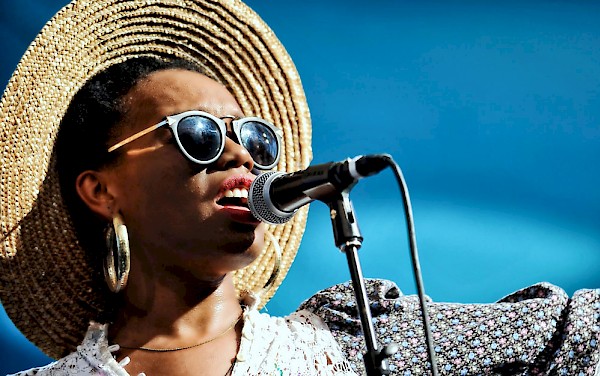 Ragen Fykes of Ural Thomas & the Pain in 2014
Ragen Fykes of Ural Thomas & the Pain in 2014
Ned Failing, the partner who primarily deals with the festival’s financials (the “unsexy” stuff, as he puts it) describes what he views as Pickathon’s effect on musical culture: “I see a lot of people keep a close eye on what Pickathon is booking. And you’ll end up seeing those acts come around afterwards at different clubs—like we’re doing some of the homework for people.”
Schoenborn describes the festival as having a built-in megaphone now: “We believe that the best music should win and that you shouldn’t have to play the popularity game that most festivals play—where you’re hiring folks that are selling the most records or shows.” The festival founders often take chances on new or unknown artists, but their instincts are so on that some of these artists simply become shooting stars in the sky.
Many artists refer to Pickathon as their favorite festival to play. Instead of spending their time in segregated green rooms, the artists mingle with the crowd, participate in the legendary square dance, jam in the woods with their fans, and feel like they’re much more than musicians-for-hire. They are part of the spectacular scene and they feel as much at home at Pendarvis Farm as anyone else.
SERIOUS FUN: FOR THE WHOLE FAMILY
Today’s Pickathon is reminiscent of those innocent halcyon days of youth, but it’s serious about kids having fun: Families are welcomed with open arms and there’s no shortage of activities for the tiniest Pickathonsters. It’s a two-week summer camp crammed into three days, with activities ranging from family yoga to an interactive circus, from nature-themed field games to a dragon parade.
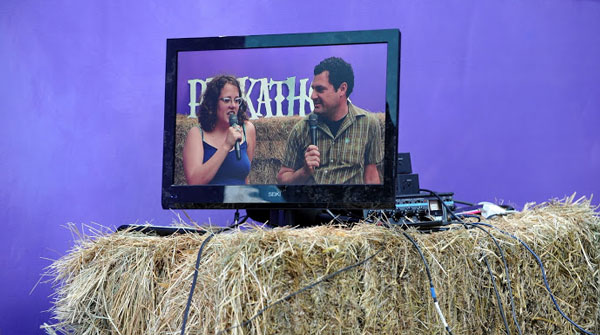 Portland's Sallie Ford sitting for an interview
Portland's Sallie Ford sitting for an interview
VIDEO AND SOUND: DOWN-HOME TECHINESS
Pickathon may convey a down-to-earth vibe with its organic assortment of barns and fields, wooden sculptures and geriatric horses, but make no mistake, state-of-the-art technology is driving this train now and into the future. Schoenborn’s unmatched fervor for his festival is well known. But within it lies an ever-growing passion: Pickathon’s film sub-industry. For years, the festival has been video recording their live acts, but since producer Ryan Stiles came on the scene a few years ago, Pickathon’s video artistry has blossomed. Stiles presides over a massive video crew. His creative direction gets input from Schoenborn and Groves, and over the years their videos have evolved. Every single camera angle is scrutinized.
Schoenborn’s vision is for the festival crowd to essentially be the studio audience for a much larger, global Pickathon media presence. Last year, Pickathon broadcast to just under 50,000 people. This year, that number may triple. To faithfully capture the Pickathon experience and translate it to the screen, the crew goes to great lengths to make viewers experience the performances in an intimate way. Online audiences see the sweat and emotion up close. Stiles wants to break the mold of “wide shot to medium shot to solo shot back to wide shot.” Pickathon applies its handcrafted slow food philosophy to its videos and stands to become trailblazers in live music filmography. This rebel festival knows what it’s doing.
The top-notch live sound quality has always been there since day one. You’ll rarely hear feedback coming from the speakers—audio craftsmen like veteran soundman Gavin Pursinger see to that. When asked why he willingly works such long, back-breaking shifts, Pursinger says, “I love meeting musicians from around the world. Some of them have 70-year-old Martin guitars, or maybe beat-up Marshalls. I just dig it. There’s no place I’d rather be.”
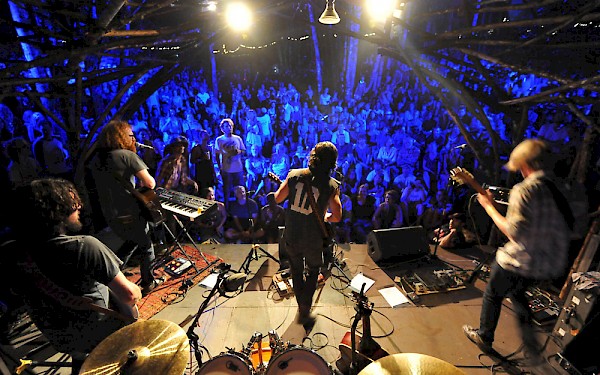 Blitzen Trapper holds court on The Woods stage
Blitzen Trapper holds court on The Woods stage
TOIL AND TROUBLE: BEHIND THE SCENES
Over 1,100 volunteers and crew members are directly responsible for making this annual event so special. Those great and quirky hay bales people sit on? They were hauled and set up by volunteers. Those amazing fairy lights in the forest? The tons of ice that keeps the beer cold? The stages, parking lines, campsites, temporary structures? It’s all the work of volunteers and crew members. Getting down to the details of how this particular sausage is made is another article altogether. Suffice it to say, many people work really hard to make sure you have the time of your life.
THE EXPERIENCE: EARNING ADMIRATION
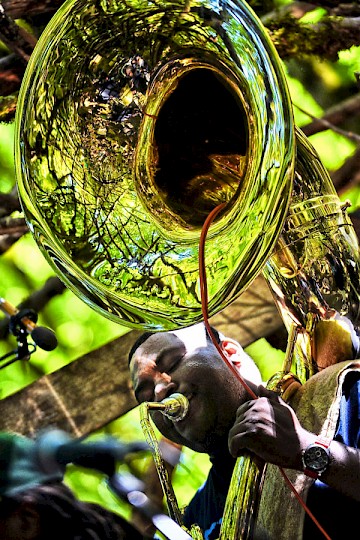 Hot 8 Brass Band on The Woods stagePickathon is so much more than a music festival—it’s an experience. To help sum up Pickathon and Pendarvia (the utopian-sounding nickname for the farm), we asked attendees via social media and received more than a few insightful nuggets:
Hot 8 Brass Band on The Woods stagePickathon is so much more than a music festival—it’s an experience. To help sum up Pickathon and Pendarvia (the utopian-sounding nickname for the farm), we asked attendees via social media and received more than a few insightful nuggets:
▶ Pickathon is as much about community and shared experience as it is about the music.
▶ Jamming in the forest until sunup, we started as strangers; we parted as dear friends.
▶ My husband and I fell in love with each other at Pickathon. It was inevitable, but the air and spirit of Pickathon accelerated the process.
▶ Pickathon is where time elongates and sporadically ceases to exist.
▶ Only at Pickathon will you hear 20 banjo players in the woods in the pitch black middle of the night.
▶ Rocking full throttle, dancing and hooting along in the Galaxy Barn at 2:30am!
▶ Pickathon is more significant for us than our wedding anniversary.
▶ It’s a psychedelic, giant, Fourth of July picnic with music you may not have heard before, but that you’ll listen to forever.
If all of this sound transcendental, idealized and perhaps even hippie-esque, it’s because it truly is. As major music festivals go, this one is a veritable paradise. Pickathon is like an alternate reality where groundbreaking music and community converge, where sustainability and technology coexist, and where mediocrity has no place. Pickathon rewrites the rules of the traditional festival paradigm, all to make sure you never forget your Pickathon experience.

